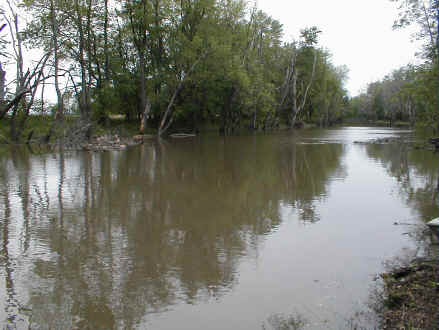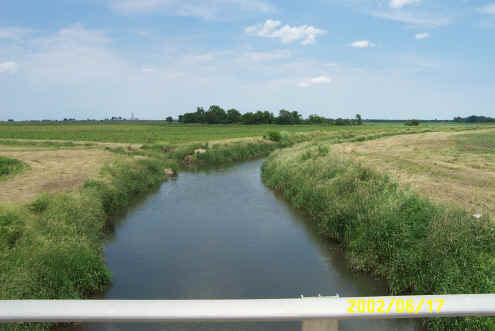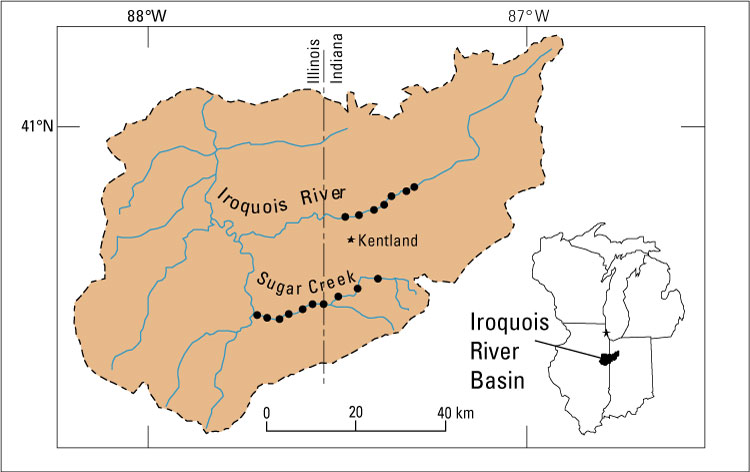

Biogeochemistry of Carbon and Nitrogen in Aquatic Environments
Research Topics Index Project Home
Field Sites: Iroquois River and Sugar Creek, Indiana and Illinois

Iroquois River near Foresman, IN., May 2000. |

Sugar Creek, Benton County, IN., 17 June 2002. |
|
Collaborators: Ronald Antweiler, USGS, Boulder, Colo. J.K. Böhlke, USGS, Reston, Va. Mary A. Voytek, USGS, Reston, Va. Judson W. Harvey, USGS, Reston, Va. Lesley Smith, University of Colorado, Boulder, Colo. Andy Laursen, Notre Dame University, South Bend, Ind. |
Field Assistance: Upper Illinois NAWQA Project, USGS Illinois District Office George Groschen, Project Chief Dave Dupre Kevin Richards |
Nitrogen contamination of surface waters is an undesirable side effect and a key concern for many agricultural practices in the U.S. Although transport of nitrogen by the Mississippi River has been suggested to be a contributing factor in the development of a hypoxic zone in the Gulf of Mexico, little is actually known about the net effect of in-stream processes on nitrogen transport in small and medium sized rivers. The goal of this project is to conduct a detailed, multidisciplinary investigation of denitrification and nitrification in two agriculturally impacted rivers. The rivers differ in size, flow, and bed sediment characteristics. The project is designed to conduct Lagrangian (time of travel) sampling to determine the overall effect of denitrification and nitrification on riverine nitrogen loads, nitrogen speciation, nitrogen isotope geochemistry, and trace constituent concentrations. This approach requires careful characterization of stream hydrology; depth and width integrated discharge, flow, and tributary inputs. In-stream tracer studies will be used to quantify the extent of hyporheic exchange. Additionally, nitrification and denitrification will be measured directly using a variety of techniques. These will include incubation techniques with stream-bed cores using 15N, quantification of within stream nitrogen/argon ratios, and molecular probe characterization of the microbial populations responsible for each activity. The information obtained from this study will provide one of the first comprehensive examinations of nitrification and denitrification in streams, from the perspective of nitrogen loads, and should facilitate evaluation of the role of these processes in mediating or mitigating transport of nitrogen (regardless of source) to coastal receiving waters. The results should also greatly improve the reliability of regional transport models that simulate nitrogen discharge in streams and rivers draining agricultural areas.

Index map of Iroquois River drainage astride Indiana-Illinois border. Circles on stream courses are sampling points examined in our study. |
Funding SourcesU.S. Dept. of Agriculture, NRICG Program USGS NRP - Hypoxia Program LinksUpper Illinois River Basin NAWQA USGS Stream gauging stations: USGS Fact sheet: Nitrogen in the Mississippi River Basin - click here Indiana Real-Time Stream Flow Data- click here. |
| Projects Index Top of Page |
| Return
to Biogeochemistry
of Carbon and Nitrogen in Aquatic Environments Home Page
USGS Home Page | USGS Water Resources | USGS Toxics Hydrology Program | USGS NRP | |